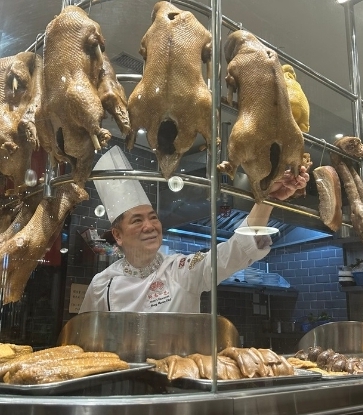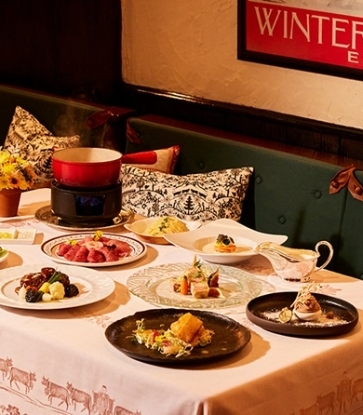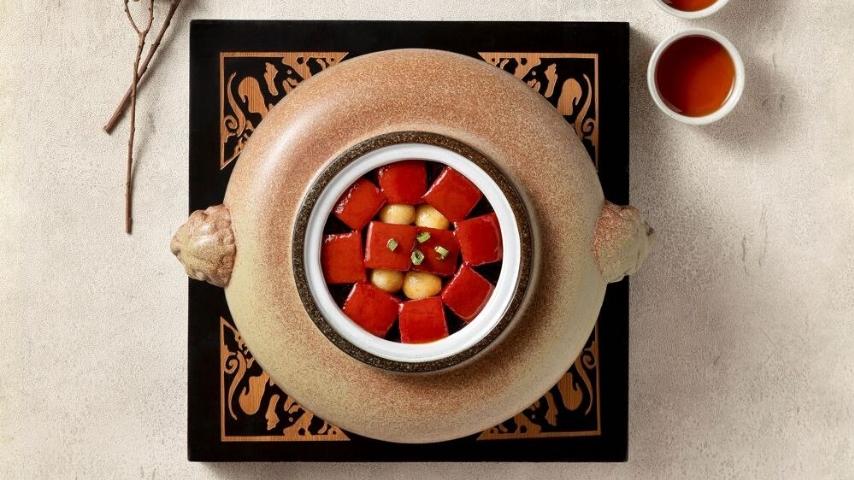"One’s destination is never a place, but a new way of seeing things," American writer Henry Miller once wrote.
Even if travel is not on your immediate agenda, there are plenty of new flavours to discover right here in Hong Kong. Rich with tales of tradition, authentic flavours and detailed decor designed for vicarious travel, these five MICHELIN-recommended restaurants in the city will take you on a gastronomic trip around the globe — no passports required.

ZheJiang Heen
One MICHELIN Star, MICHELIN Guide Hong Kong Macau 2020
Considered one of the eight great culinary traditions of Chinese cooking, ZheJiang cuisine emerged from the rich and populous cities such as Hangzhou, Ningbo, Shaoxing and Wenzhou.
The region in China's eastern coastal area to the south of the Yangtze Delta is known for producing high quality fish and shrimps. The opulent region has attracted wealthy merchants and high-ranking officials alike since the Tang and Song dynasties, who have nurtured a highly refined cooking tradition, known for its freshness and fragrance.
In Hong Kong, Zhejiang Heen was founded 2011 by a group of Zhejiang natives homesick for the food of their hometown, but the quaint Wan Chai eatery quickly and unexpectedly rose to popularity. After clinching its first MICHELIN star, eminent personalities and celebrities started to patronise the restaurant, which is the only restaurant in the MICHELIN GUIDE Hong Kong Macau that serves Zhe Cuisine.
A particular favourite of Zhejiang Heen's head chef Pan Jiulong is the Dong Po Beef, which uses US beef in place of the traditional braised pork belly. Another signature dish, Sauteed Eel With Chives, uses only the most tender tail flesh of a yellow swamp eel. A total of 1.2 kilogram of eel is used for each plate. Other signatures include Braised Pork With Squid, Fried Crab in Soy Sauce with Rice Flour Cake, and Steamed Shad Fish.
What our inspectors say: At what must be one of the easiest restaurants to find – just look for the huge Zhejiang landscape on the outside of the building – you’ll find authentic Zhejiang and Shanghainese specialities made from top quality ingredients, such as smoked fish, shrimps with seaweed, and steamed shad fish.
YOU MAY BE INTERESTED: Ingredient: Red Mushrooms From China’s Wuyi Mountains

Bombay Dreams
MICHELIN Plate, MICHELIN Guide Hong Kong Macau 2020
If a restaurant can survive Hong Kong's highly competitive restaurant industry for almost two decades, you know it's not your average restaurant. Bombay Dreams is one such address. Established in 2002, the restaurant in Central offers a swath of flavours reflective of the vast lands and vibrant food culture of India.
Head chef Irshad Ahmed Qureshi comes from a family of chefs spaning seven generations and overlooks no detail when it comes to serving quality food: from the housemade yoghurt used for marination, to the avoidance of artificial meat tenderiser and synthetic food colouring in his recipes. To ensure the tenderness of their meat, the kitchen uses the traditional Indian method of using marinating them with green papayas instead of meat tenderiser, while turmeric and natural spices are used to add dashes of colour — and plenty of personality.
No Indian restaurant is complete without a tandoori oven, and the ones at Bombay Dreams turn out fresh chicken and prawns grilled à la minute, making them a must-try at the restaurant. Don't miss the desserts, such as as Kulfi, a traditional Indian ice cream that come in various flavours such as saffron. Paired with pistachios, each spoonful will permeate your palate with a nutty aroma and the richness of dairy, making a sweet and perfect end to a meal.
What the Inspectors Say: Tucked away on the 4th floor of an unremarkable building is something of an institution – this Indian restaurant has been operating here since 2002. The jars of spices that line the shelves tell you this is a kitchen which takes spicing seriously. There’s a great value lunch buffet but go for the à la carte for original, well-crafted dishes with an emphasis on northern India – specialities from the tandoor are a highlight.
RELATED: Kitchen Language: What is a tandoor?

Chesa
MICHELIN Plate, MICHELIN Hong Kong Macau 2020
Located in The Peninsula Hong Kong, Chesa, which opened its door in 1965, is not only one of the few venues serving Swiss cuisine in Hong Kong, it is also one of the oldest. According to group executive chef Florian Trento, a Swiss native, the restaurant was birthed in 1963, after the hotel and Switzerland's national carrier Swissair co-organised a Swiss Food Festival with a spectacular turnout. Encouraged by its unprecedented success, the hotel decided to permanently open a Swiss restaurant to bring authentic alpine cuisine to Hong Kong diners.
Like a walk-in lavish time capsule, the traditional timber structure, wooden veneer and textured stucco decor in Chesa remind one of a country house from the Grison region in eastern Switzerland. The dining hall features antique ornaments, such as a clock with only an hour hand and a hope chest made in 1723, that are part of the collections brought back from Switzerland by the then-general manager Peter Gautschi and designer Dexter Yeh.
Food-wise, Chesa overs over 20 menu items that include a variety of Swiss signatures. The most famous among them is the Cheese Fondue. Two options are available for the western-style hotpot: the Fondue moitié-moitié which uses Gruyère and Vacherin Fribourgeois cheeses; or the Fondue Montagnarde which uses Emmentaler, Appenzeller, Gruyère and Parmesan cheese. The former is robust in flavour, and is best enjoyed with a freshly baked baguette, while the latter is cooked with bacon and its lighter relish makes it a perfect match for spaghetti and boiled potatoes.
Other Swiss delights, such as the Emincé de Veau Zurichois (veal fillet with mushroom cream sauce) and handmade sausages with Spaetzle noodles are also available on the menu.
What the Inspectors Say: The room may be windowless but the authentic chalet-style decor is unmistakably Alpine. It has been welcoming devotees of all things Swiss since 1965, having originally opened as a ‘pop-up’ by the Swiss-born manager at the time. It offers everything from fondue and raclette to the famous Chemin de Fer wines. Authenticity is assured as the current executive chef of the hotel is also Swiss and keeps a close eye on everything they do here.
EXTENDED READING: New Stars Of The MICHELIN Guide Switzerland 2020 Announced

Qi - Nine Dragons
MICHELIN Plate, MICHELIN Guide Hong Kong Macau 2020
Located in Tsim Sha Tsui, Qi is named after the Chinese character for "shining star" in reference to the star anise, a common spice used in Szechuan cuisine. The 2,000-square-foot eatery is renovated in contemporary Chinese style, featuring floor to ceiling windows overlooking the night view of Tsim Sha Tsui. Qi - Nine Dragons has attracted local and foreign foodies alike.
Head chef Chan Wai Kin has more than decade of experience cooking Szechuan dishes, and stocks his larder with sauces, spices and chilli directly imported from Sichuan to ensure that flavours stay authentic. There is no such thing as one spice fits all at Qi: Chan uses an assortment of methods such as dehydrating, grounding, pickling and crushing his chilis to prepare the myriad iterations of the spice that take centre stage in his cooking.
The signature to order here is the Sugar Glazed Ginger And Scallion Beef, which is inspired by a Szechuan classic dish of crispy beef slices. Chan's version features a thick gravy made with ground ginger and chili flakes, along with deep-fried beef slices wrapped in bread crumbs. Although most diners come for the spicy dishes, non-spicy options are also available on the menu, such as the Stir-fried Tiger Prawns with Cashews Nuts.
What the Inspectors Say: Before you taste the creative Sichuanese fare, feast your eyes on the dining room itself – a dragon mural, carved wood panels and red accents are juxtaposed with Hong Kong’s electric skyline. Guests can also opt to dine al fresco on the rooftop terrace. Must-try dishes include sugar-glazed ginger beef, and fish fillet in chilli oil soup. New items are added to the menu regularly, such as Sichuanese seafood stone pot rice.
READ ALSO: A Meal with Chen Kentaro of Shisen Hanten

Kaum by Potato Head Hong Kong
MICHELIN Plate, MICHELIN Guide Hong Kong Macau 2020
As a Hong Kong offshoot of the ultra-chic Potato Head Group of Bali, Kaum specialises in Indonesian food with a generous side serve of style. The word “Kaum” means clan or tribe in the indigenous language of the Indonesian island, which is apparent throughout the restaurant's interiors by Japanese designer Sou Fujimoto. The 8,000 square foot restaurant is divvied into 3 main sections: a music room with a live DJ that spins picks from the restaurant's vinyl selection every Thursdays to Saturdays; a bar that serves Indonesian-inflected cocktails; and two main dining chambers in contrasting fashion. Antique ornaments, wooden ceiling panels handmade by artisans of the Toraja tribe in South Sulawesi, and bespoke furnitures are crafted from teak add plenty of tribal flavour.
The menu at Kaum offers a generous selection of over 40 items, the most popular among them being the Babi Guling, or roasted boneless baby quarter pig. The pork is first marinated with over 10 Indonesian spices before grilling, which results in a crisp and glistening skin that sheaths richly spiced and moist meat underneath.
Another popular order is the Gado Gado Salad, which is served with a homemade dressing consisting of white cashews and peanuts that help to contrast acidity of the salad with a nutty fragrance. While you are tucking into the grilled-to-order satays and the restaurant's homemade traditional sambal sauces, don't forget to admire the exquisite folk designs of the plates upon which the dishes are served, bringing the tribal theme full circle.
What the Inspectors Say: An all-in-one boutique, bar-lounge and restaurant that celebrates all things Indonesian. The latter is furnished with beautiful Toraja tiles and upholstery, which lend a nostalgic feel. The menu covers different styles of the vibrant indigenous cuisine. All dishes are appealingly priced and come in portion sizes big enough for a few to share. Parties of six or more can order the special menu to sample a variety of culinary highlights.















